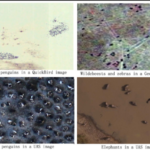Your smartphone dies at the worst possible moment. Your fitness tracker needs to be charged again. That smoke detector starts chirping at 3 AM because its battery’s running low. We’ve all been there.
What if these everyday frustrations could disappear? A new solar technology is emerging that doesn’t require massive rooftops or sprawling solar farms to work effectively. It is perovskite solar cells, thin enough to slip into the devices you already own, efficient enough to keep them running, and cheap enough to make energy independence accessible to everyone.
We’re about to explore how this technology achieves efficiency rates that match those of traditional solar panels, while being 400 times thinner. We’ll also examine why it excels at powering small devices in ways silicon never could, and what the realistic timeline looks like for actually getting these products into your hands. But first, let’s talk numbers.
When Thin Beats Thick
Here’s something that might surprise you. Perovskite solar cells have already hit 26.1% efficiency in laboratory conditions – exactly matching the best silicon panels on the market today. That alone would be impressive for a technology that’s been in serious development for less than a decade.
But the real magic happens when you layer perovskite on top of silicon. These tandem configurations are pulling 34.6% efficiency right now, with projections reaching 43% by 2040. Silicon’s theoretical ceiling? 29.4%.
The manufacturing story gets even better. While silicon requires energy-intensive, high-temperature processes that melt sand, perovskite cells are grown from simple chemical solutions. Think of it like developing a photograph, but you end up with a solar panel instead of a picture. This process could potentially cost 10 times less than producing crystalline silicon at scale.
Here’s where it gets interesting for everyday applications. That 400-fold difference in thickness isn’t just a neat engineering trick – it opens up possibilities that silicon simply can’t match. You can bend perovskite cells. Roll them. Stick them on curved surfaces. Make them transparent enough for windows that generate electricity while you look through them.
This flexibility changes everything about where solar power can go.
Small Devices, Big Independence
Walk through your home and count the battery-powered devices. Smoke alarms, motion sensors, remote controls, wireless cameras, and smart thermostats. Each one is a small energy consumer that occasionally demands your attention.
Perovskite technology excels precisely where silicon struggles most, in low-light conditions. While traditional solar panels become nearly useless under indoor lighting or on cloudy days, perovskite cells maintain relatively high efficiency even with diffuse light sources. This isn’t theoretical anymore.
Researchers at Oxford’s National Thin Film Cluster are developing portable solar panels that adhere directly to devices, capturing ambient light to maintain steady charging. Imagine your wireless earbuds case with a thin solar film on top, slowly charging throughout the day just from room lighting. Or motion sensors that never need battery replacements because they’re constantly sipping power from whatever light hits them.
The applications extend beyond simple gadgets. Building-integrated photovoltaics are particularly promising in densely populated areas like Japan and Singapore, where space is at a premium while energy demand is high. Solar facades, translucent windows, and even non-load-bearing rooftops can generate electricity without requiring dedicated land resources.
But perhaps most importantly for global energy access, this technology works in remote areas where grid infrastructure doesn’t exist. A thin, flexible solar cell that costs a fraction of silicon panels could power communication devices, medical equipment, or educational tools in regions that traditional energy solutions can’t reach economically.
The shift from centralized to distributed energy generation starts with these small applications.
From Lab Bench to Market Reality
Let’s be honest about where we are. The global perovskite solar cell market was valued at US$ 350.07 million in 2024. That’s tiny compared to the overall solar industry. But here’s what matters. It’s projected to reach $8.8 billion by 2034, representing a compound annual growth rate of 38.05%.
These aren’t wishful thinking numbers. Commercial products are expected as early as 2025, with gigawatt-scale manufacturing beginning in 2028. The Netherlands Enterprise Agency recently funded the Perovision Project, targeting results in 2027 and full-scale production by 2030.
This timeline reflects something important about how new energy technologies reach the market. They don’t replace everything overnight. Instead, they find niches where their advantages outweigh their current limitations. For perovskite, that means starting with indoor energy harvesting, portable electronics charging, and specialized building integration.
The path forward focuses on complementing existing technology rather than wholesale replacement. As one researcher noted during my investigation into this space, the ability to tune perovskite materials to absorb specific wavelengths while allowing others to pass through makes them ideal partners for silicon in tandem configurations.
That approach makes sense. Work with what we have while building toward what we need.
Challenges Worth Acknowledging
No technology comes without trade-offs, and perovskite solar cells face real challenges that manufacturers are actively working to solve. The materials are sensitive to moisture, oxygen, heat, and ultraviolet light, basically everything they’ll encounter in real-world conditions.
Recent research from the Hong Kong University of Science and Technology identified specific crystalline microstructure issues contributing to degradation and developed chemical engineering techniques to improve stability. Innovation is happening, but it’s measured and methodical rather than breakthrough-driven.
Lead content in many high-performing formulations raises environmental questions as well. Researchers have demonstrated working cells using tin instead, though currently at lower efficiency levels. The recycling and disposal strategies still need development.
These aren’t insurmountable problems, but they explain why initial applications focus on protected environments or specific use cases where the advantages outweigh current limitations.
The Distributed Energy Future
Here’s what strikes me most about perovskite technology. It’s not trying to power your entire house or replace utility-scale solar farms. Instead, it’s quietly solving the small energy problems that silicon never could address effectively.
The future this technology points toward isn’t about massive infrastructure projects. It’s about energy generation becoming more distributed, more accessible, and more integrated into the devices and buildings we already use. That’s a different kind of energy independence – one that starts small and grows from there.
 Streamlining Clinical Trials: How EDC Software is Revolutionizing Medical Research
Streamlining Clinical Trials: How EDC Software is Revolutionizing Medical Research Scientists Continue Their Quest To Find Dark Matter
Scientists Continue Their Quest To Find Dark Matter Satellites Are Tracking Animals Using Satellite Imagery
Satellites Are Tracking Animals Using Satellite Imagery The Battle Over Intellectual Property And Training of Artificial Intelligence Models
The Battle Over Intellectual Property And Training of Artificial Intelligence Models Are Heat Shields The Key to Unlocking a Future Space Economy?
Are Heat Shields The Key to Unlocking a Future Space Economy? Space Manufacturing Is About To Get Real
Space Manufacturing Is About To Get Real New Ways To Sequester Carbon Despite Retreat From Climate Change Action
New Ways To Sequester Carbon Despite Retreat From Climate Change Action Artificial Intelligence Equipped Robots Taking Us To The Cleaners And We Are Happy About It
Artificial Intelligence Equipped Robots Taking Us To The Cleaners And We Are Happy About It
